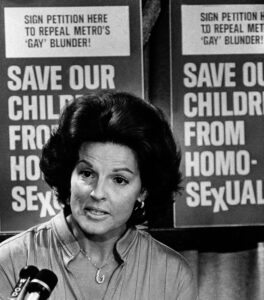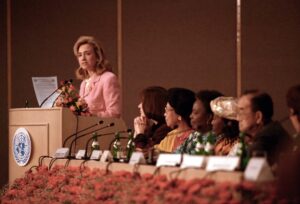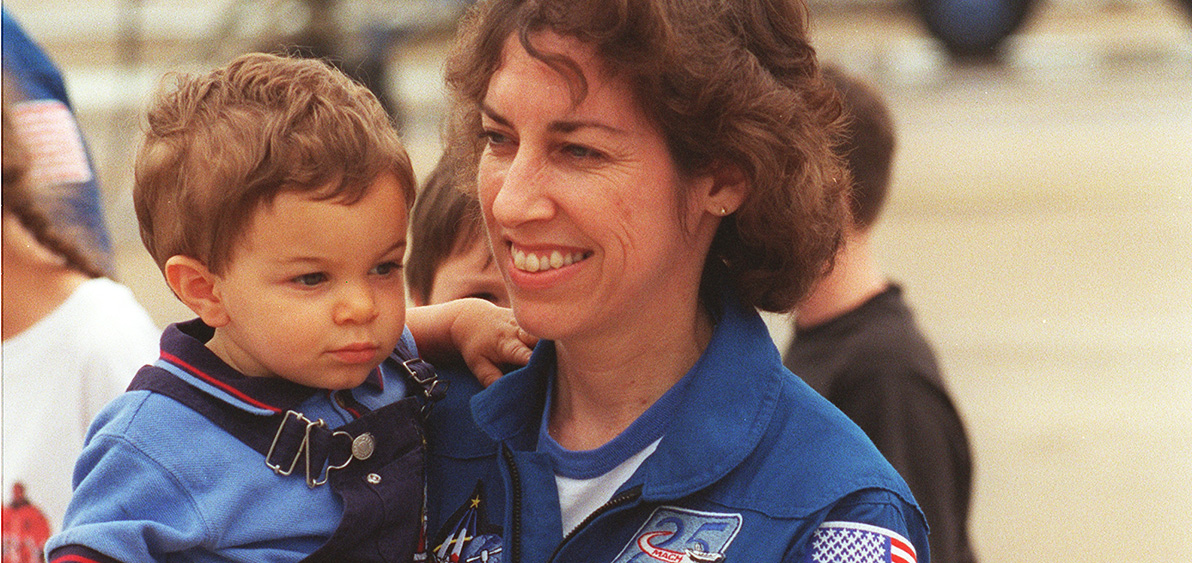Key Ideas
- Women contributed to the conservative movement (and resistance to it) in the 1980s as well as the resurgence of progressive politics in the 1990s.
- Greater access to information and technology changed the daily lives of women from many different backgrounds.
- The gains of the 1970s feminist movement allowed women greater access to opportunities in education, politics, and the workplace, although these opportunities were different for women of diverse backgrounds.
- The experiences of women in this period varied widely based on race, class, age, gender identity, and geographic region.
Introduction

Singer and anti-gay activist Anita Bryant is heading up a crusade to nullify a local gay rights ordinance, Feb. 15, 1977. Bryant calls the group “Save Our Children” and vows it will represent the rights of the majority of citizens. (AP Photo)
The United States experienced turbulent social change in the 1960s and 1970s. By the end of the 1970s, Americans had redefined what it meant to be American and participate in society. As the Cold War continued to play a major role in foreign policy, the United States expanded its leading position in global politics. The 1980s and 1990s were dominated politically by economic challenges and each decade reflected the ideologies of the presidents that led the nation: Ronald Reagan and his conservative trickle-down economics in the 1980s, and Bill Clinton’s neoliberal policies in the 1990s. Toward the end of the 20th century, Americans faced the following questions:
- What does it mean to be an American, and how do Americans each play their role in society? How did the population shift to a more diverse society impact this question?
- What role should the United States play in promoting and protecting freedom and democracy globally?
- What level of involvement should the government play in the lives of its citizens, particularly citizens in need?
Women were more visible than ever in these conversations. The gains of the previous decades led to greater participation of women in education, politics, and the workplace. The conservative ideology of the 1980s effectively slowed momentum toward full gender equality and resulted in policies that specifically limited the economic security and independence of lower-income women and women of color. In response, the liberal movement in the 1990s reclaimed feminism and redefined the term for the next generation, a generation that was more diverse than ever as the population of the United States grew more racially diverse. Throughout these two decades, greater access to information, through television, print media, and, eventually, the internet, provided new avenues for debating the role of women in American society. Increased media access through cable television and the internet also led to greater scrutiny of women and their actions, regardless of their political and social agendas.
End of the Twentieth Century, 1977–2001 is divided into two sections, organized by period. A Conservative Turn, 1977–1992, focuses on the long 1980s, when conservative thought ruled American politics and society. It examines both the expansion of conservative policies and resistance to it, both of which were often led by women. The Information Age, 1991–2001, covers the swing toward liberalism, including third-wave feminism in the 1990s, and ends with a major turning point in American life and politics, the terrorist attacks of September 11, 2001.
The resources in this unit can be explored by section or by theme. Background information and vocabulary lists provide context for each resource. Resources also include suggested activities and how to combine different resources on a certain topic. You can easily integrate these materials into current lesson plans or structure new lessons around them. Many resources in this unit speak to current political and social issues and can be plugged into lessons that address current events.

FIRST LADY HILLARY RODHAM CLINTON REMARKS FOR THE UNITED NATIONS FOURTH WORLD CONFERENCE ON WOMEN BEIJING, CHINA SEPTEMBER 5, 1995 , Fourth World Conference on Women by the United Nations Development Programme (UNDP) in collaboration with the United Nations Fourth World Conference on Women Secretariat.
Unit Essential Questions
- How did women benefit from the gains of the feminist movement of the 1970s? How did they support and fight against the conservative backlash in the 1980s? How did they continue and redefine feminism in the 1990s?
- How did women fight against inequalities during this time period?
- What impacts did technology, economics, and foreign policy have on women of different backgrounds?
- How did women’s experiences vary depending on race, class, age, gender identity, and geographic region?
Explore by Section
To learn about the end of the Twentieth Century by topic, explore the two sections below!
A Conservative Turn, 1977-1992
The 1980s were defined by a political shift toward conservatism and women both were a part of this movement and pushed against it.
Go NowThe Information Age, 1991-2001
Increased access to information through new mediums and a resurgence of the feminist movement defined women’s lives in the 1990s.
Go NowExplore by Theme
Explore resources related to common curricular topics and themes.
View All Resources
Discover all the resources in this unit below and click through to the sections to find even more background information.







